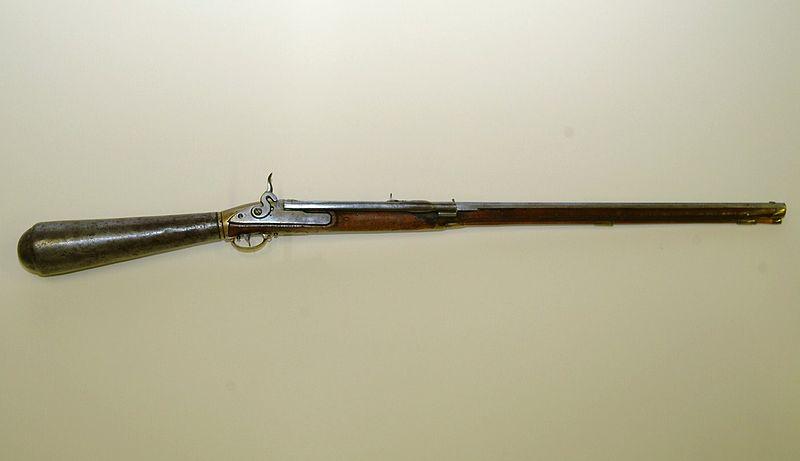This is one of the most interesting videos I have watched in a very long while and a must-watch for any firearm enthusiast.
Half of the US land mass was conquered by merely demonstrating this amazing rifle.
Girandoni air rifle as used by Lewis and Clark. A National Firearms Museum Treasure Gun
The modern .45 calibre airgun
The Girandoni air rifle was in service with the Austrian army from 1780 to around 1815. The advantages of a high rate of fire, no smoke from propellants, and low muzzle report granted it initial acceptance, but it was eventually removed from service for several reasons.
While the detachable air reservoir was capable of around 30 shots it took nearly 1500 strokes of a hand pump to fill those reservoirs to around 800 psi.
Later, a wagon-mounted pump was provided. The reservoirs themselves, made from hammered sheet iron held together with rivets and sealed by brazing, proved very difficult to manufacture using the techniques of the period and were always in short supply.
In addition, the weapon was very delicate and a small break could make it inoperable. Finally, it was very different from any other weapon of the time and any soldier using it needed to be highly trained.
The Lewis and Clark Expedition used the rifle in the demonstrations that they performed for nearly every Native American tribe they encountered on the expedition.
Design and capabilities

The rifle was 4 ft (1.2 m) long and weighed 10 lbs (4.5 kg), about the same basic size and weight as other muskets of the time. It fired a .46 caliber ball at a velocity similar to that of a modern .45 ACP and it had a tubular, gravity-fed magazine with a capacity of 20 balls. This gravity operated design was such that the rifle had to be pointed upwards in order to drop each ball into the breech block. Unlike its contemporary, muzzle-loading muskets, which required the rifleman to stand up to reload with powder and ball, the shooter could reload a ball from the magazine by holding the rifle vertically while lying on his back and operating the ball delivery mechanism. The rifleman then could roll back into position to fire, allowing the rifleman to keep a "low profile".
Contemporary regulations of 1788 required that each rifleman, in addition to the rifle itself, be equipped with three compressed air reservoirs (two spare and one attached to the rifle), cleaning stick, hand pump, lead ladle, and 100 lead balls, 1 in the chamber, 21 in the magazine built into the rifle and the remaining 80 in four tin tubes. Equipment not carried attached to the rifle was held in a special leather knapsack. It was also necessary to keep the leather gaskets of the reservoir moist in order to maintain a good seal and prevent leakage.
The air reservoir was in the club-shaped butt. With a full air reservoir, the Girandoni air rifle had the capacity to shoot 30 shots at useful pressure. These balls were effective to approximately 150 yards on a full load. The power declined as the air reservoir was emptied.
Importance
The Girandoni air rifle was an important first. It was the first repeating rifle of any kind to see military service. It was one of the first uses of a tubular magazine. And, although it saw service for only 35 years, it predated and was more advanced in design and mechanical technology than the Henry rifle which arrived fifty years later.
Source: http://en.wikipedia.org/wiki/Girandoni_Air_Rifle
No comments:
Post a Comment
Note: only a member of this blog may post a comment.